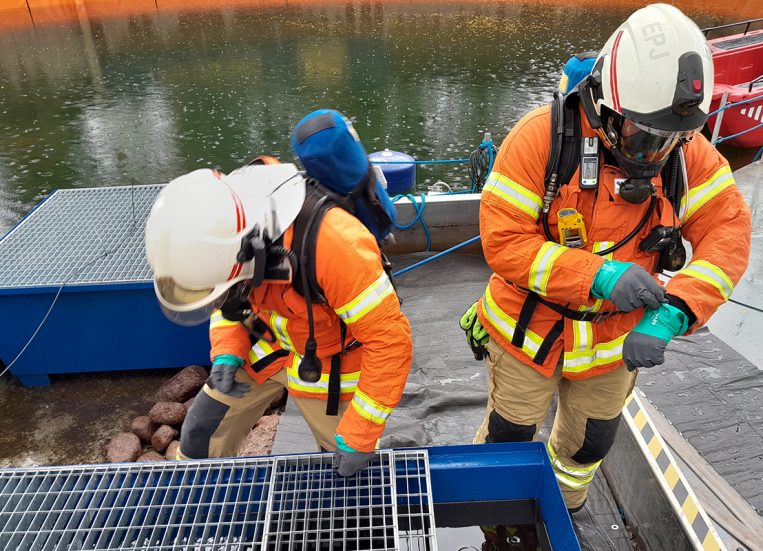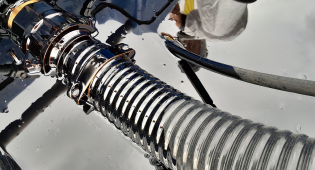Crude oil spill response preliminary tests preparing the ground for further studies
27.05.2024Responding to a marine crude oil spill is an inherently hazardous operation. The properties and behaviour of the substance and their changes with varying conditions need to be considered in the level of protection and operational models of response personnel.
In September 2002, small-scale field tests were carried out in Xamk’s oil spill response basin to measure the flammability and harmful concentrations of crude oil (Brent, Crude Oil, Sweet). The recoverability of crude oil by brush and disc skimmers was also compared, and the performance of absorption products was tested. The tests were carried out together with Neste and Kymenlaakso Rescue Service. The test was the first and will serve as a pre-test for a larger series of tests to be carried out in May-June 2024.
This article highlights some observations from the tests and the results compiled by Esa Järvisalo (2024). The tests were conducted and analysed as part of the Emergency Services Academy Finland thesis. The tests were carried out in relatively chilly autumn conditions on only tens of litres of oil, so care must be taken in translating and interpreting the results in relation to the predicted risk of thousands of tonnes of crude oil spill.
Flammable and harmful to health
Crude oil is highly volatile, and its vapours may form a flammable mixture with air. It is also highly toxic, especially in the early stages of an incident, when the BTEX compounds (benzene, toluene, ethylbenzene, and xylene) volatilise (Nissinen 2000; Järvisalo 2024).
Before the tests were started, a small quantity of crude oil was subjected to a fire test in a small fire sink. The oil, which had been evaporating in the open air for two hours by then, ignited very easily. The following day, based on the flammability measurements and the second burn test, the oil’s flammability had decreased, so it was considered safe to start the oil recovery tests (Järvisalo 2024).
Even if the LEL-% meter measuring the risk of ignition and explosion shows very low concentrations, so there is no longer any particular flammability risk, crude oil can still emit harmful concentrations to health. Over time, concentrations of harmful substances are reduced. However, hydrocarbons continued to be released into the air the next day despite the oil having been exposed in the open basin overnight (Järvisalo 2024).
Safe access and operation ensured by measurements
When approaching the incident site and before starting the response operation, measurements should be taken to ensure that concentrations are at a level that allows safe reconnaissance and response activities to begin.
Measurements should also be taken to ensure that no flammable mixture is formed in the vessels’ cargo holds. Oil spill response vessels and other units should have the capability to measure both the flammability concentration and the hydrogen sulphide concentration. Similarly, equipment should be available to measure concentrations of gases harmful to health. (Järvisalo 2024.)
Concentration measurement and personnel protection must be maintained throughout the operation, as changes in conditions, the quantity of material, the evaporation surface area, and crude oil handling and recovery will affect concentrations (Järvisalo 2024).
Preliminary results on recoverability
The tests showed that the disc skimmer was more suitable for this type of low viscosity crude oil. When oil was recovered with a disc skimmer, no water was found to be mixed with the oil. Similarly, when using a brush skimmer, the water content multiplied, and the total liquid volume increased by more than 210%. (Järvisalo 2024.) The flammability concentrations were also higher with the brush skimmer than with the disc skimmer, even though the oil was fresher when the disc skimmer was used.
Further studies are on the way
The results allowed an assessment of the level of protection of the personnel involved in the response and the safe response procedures (Järvisalo 2024). The results also provided valuable information that enabled the conception of larger-scale tests. These will be carried out in three two-day test sessions with the Rescue Services, the Border Guard, Neste, and the environmental authorities. Further research will be carried out under the Data for Safer Oil Spill Response (Datasta turvaa öljyntorjuntaan) project.
Project Data for Safer Oil Spill Response will be implemented between 1.9.2023–31.12.2024. The project is funded by the Kymenlaakso Regional Council from AKKE Funds, and Xamk. The Xamk oil spill response basin was created in 2019–2021 in ERDF-funded projects Oil spill response research and testing environment (A75152 and A75160) and has since been developed with Xamk’s resources.
References
Järvisalo, Esa-Petteri 2024. Työhygienia ja keräysmenetelmät raakaöljyonnettomuudessa (Work hygiene and collection methods in crude oil accident). Pelastusalan päällystötutkinto (AMK), Fire Officer’s Degree (UAS). Pelastusopisto. Available at: https://urn.fi/URN:NBN:fi:amk-202404166609
Nissinen, J. 2000. Raakaöljyä Suomenlahden laineille. Katsaus raakaöljyn ominaisuuksiin, ympäristövaikutuksiin, torjuntaan ja onnettomuuksien historiaan eteläisillä aluevesillämme. Suomen ympäristökeskus, Helsinki.

































